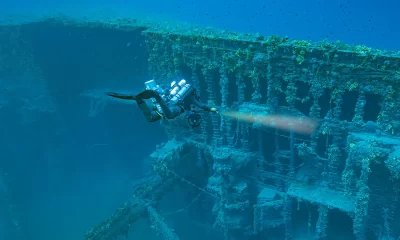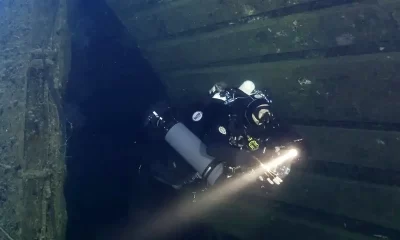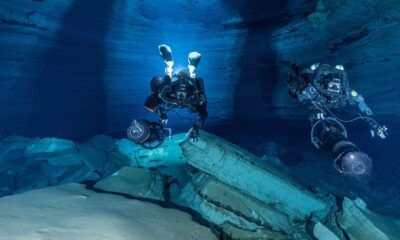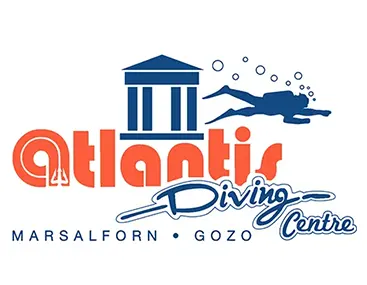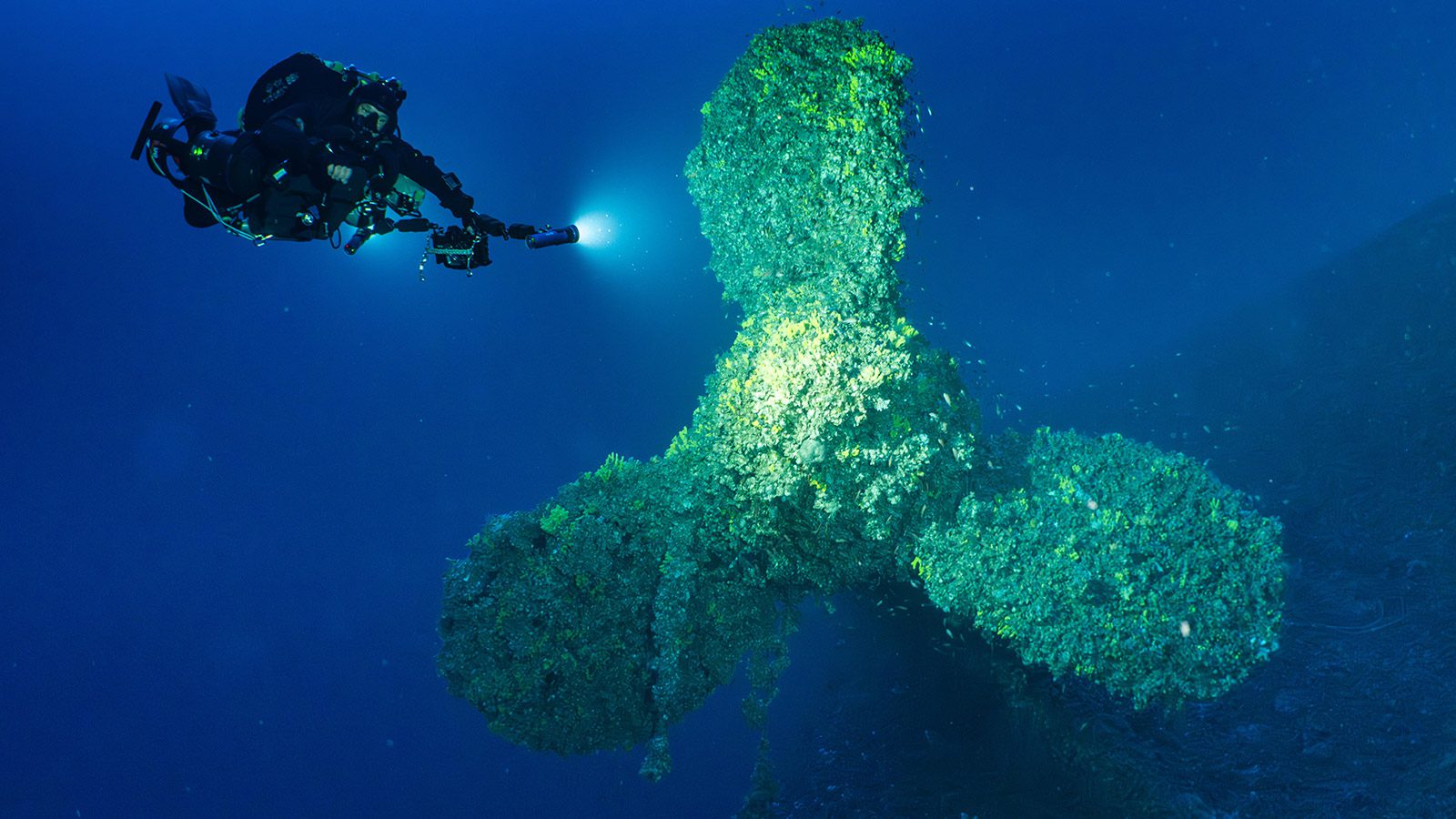
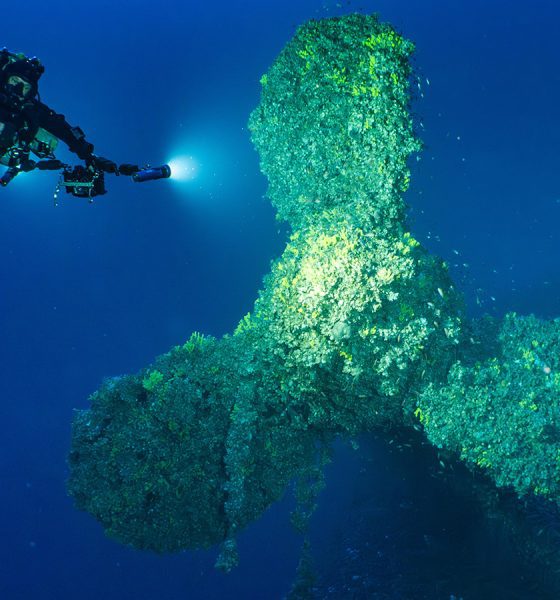
Latest Features
DIY: Braving the Britannic Without A Golden Ticket
Until recently, diving the HMS Britannic meant a major expedition with special permitting and the funding to deal with the complex logistics involved in conducting this level of diving from a remote Greek island. However, the creation of the Kea Underwater Historic Park (KUHP) in June 2022, has opened up a new approach to permits and logistics for diving this historic wreck. Brett Eldridge and Ben Lair are the first to report on their alpine-style campaign on the iconic shipwreck. Inflatables anyone?
By Brett Eldridge with Ben Lair. Lede image: Ben Lair lighting up the port side prop of the Britannic. Photos courtesy of Brett Eldridge unless noted.
In October 2023, a small group of three divers (Brett Eldridge, Ben Lair, and Justin Judd) from the United States went to dive what we consider to be one of the pinnacles of open ocean wreck diving: the HMHS Britannic. The unusual aspect of this expedition is that it wasn’t government funded, wasn’t part of a big fancy Hollywood production, and didn’t require extraordinary special permits—they were just three “ordinary” technical divers looking to dive the infamous luxury liner that sank off the island of Kea in Greece. So how did they do it without a “Golden Ticket?”
This article will detail our trip, the logistics, the gear used, and the diving operations to dive a nearly 122 m/400 ft deep, rarely-visited wreck in the middle of a busy shipping channel.
Getting a Golden Ticket
The hit novel Charlie & the Chocolate Factory is centered around a poor paperboy, Charlie Bucket, who is trying to find one of only five “Golden Tickets” hidden inside the global supply of chocolate Wonka Bars. The winners that find the five “Golden Tickets” each receive a tour of the mysterious Wonka candy factory and a lifetime supply of chocolate. In popular culture, the phrase “Golden Ticket” has come to describe something which is so rare, so unattainable, that it grants the receiver, “an extremely valuable opportunity or means of access to something desired.”

Before June 2022, you literally needed a “Golden Ticket” before you could even consider diving the Britannic. In this case, the Golden Ticket was a permit issued by the Greek government and/or the owner of the Britannic, Simon Mills. Even if you did get a Golden Ticket, it was daunting to organize the incredibly complex logistical hurdles necessary to execute this level of diving from a small, remote Greek island.
Previous Expeditions
There are numerous expeditions that have explored and documented the Britannic, so diving it isn’t completely “new.” However, a few examples will help clarify what executing a Britannic trip used to look like.
2009 National Geographic Britannic Expedition: This expedition was led by Carl Spencer in concert with National Geographic and is detailed in a book, “Mystery of the Last Olympian” by Kohler and Hudson. Granted, this was a “full on” expedition: They had a 61 m/200 ft long dive vessel geared for technical diving with multiple compressors, chase boats, tenders, and an onboard decompression chamber. Their vessel picked up all of their dive equipment, absorbent, cylinders, and other supplies from the UK prior to going to the Aegean. Kohler’s book is littered with tales of woe about the Greek permit process. Below is a photo from Richie’s website of their dive vessel:

1999 GUE Jablonski Expedition. This expedition was conducted in the early days of Global Underwater Explorers (GUE); it was the third “technical diving” expedition to the Britannic. As Jarrod notes in his original article, “Logistically speaking, the Britannic provides several interesting obstacles to staging an exploration project.” He mentions the busy shipping lane, the 122 m/400-foot depths, unpredictable currents, storms, winds, etc. None of that has really changed.
However, he also mentions the equipment logistics, the 3,200+ km/2,000+ mile journey and the need to ship “almost all of our equipment to Greece” and notes that “roughly 4,000 pounds of gear began its long journey to the lonely island of Kea” that were on “two transport trucks with over three tons of gear, compressors, and gas cylinders.” He goes on to state that “the government has historically limited access” and that to do this they “had to build an on-site facility capable of supporting up to a dozen gas divers a day.”
Even as recently as the 2019 expedition, which Aryton documents in his book with Scott Roberts, “Expedition Britannic : Diving Titanic’s Sister Ship,” he describes the complexities of permits and equipment logistics. Of the permit process, he notes that “it is essential that all permits are obtained correctly and well in advance” and that “quite a few hoops have to be negotiated with the Greek government.” For two years they played, as he called it, “the waiting game.” In terms of equipment logistics, they didn’t want to “be reliant on freight forwarding companies” and they ended up having somebody drive a van all the way from the UK with “in excess of 50 full cylinders!”
So, how did three normal divers from the United States without the infrastructure and funding of a government, non-profit, or Hollywood movie company actually pull this trip off?
Kea Underwater Historic Park (KUHP)
The answer to the above question lies primarily in the efforts of Yiannis Tzavelakos from Keadivers and others who desired to open up the amazing wrecks in the area to more than just extremely well-funded expeditions. They spent a lot of time and effort working with the ministries of Culture, Tourism, and Shipping along with support from some high ranking Greek government officials. The result was the creation of the Kea Underwater Historic Park (KUHP) which was ratified in June 2022 and heralded in a new approach to permits and logistics for diving these historic wrecks. See: Kea Opens Spectacular Shipwreck Dive Sites
Just to be clear: This doesn’t simplify the qualifications and experience required to dive a nearly 120 m deep wreck in the middle of a shipping channel with sometimes raging currents. As part of the KUHP agreement, there are still stipulations like (1) the need for an approved guide on all dives and (2) unfortunately, no interior penetration (without an additional, special permit). However, what it does simplify immensely is the permit and gear/gas logistics.
Gearing Up
I had desired to dive the Britannic for a very long time, but there were two big hurdles to overcome. One was largely in my control: training and experience. The second was, until this point, largely out of my control: permits and logistical costs and complexities.
When Ben Lair and I first learned of the change in the permit process in mid-2022, we immediately reached out to Keadivers to start arranging a trip for 2023. It took some time and a few Zoom sessions to coordinate, but we decided on dates in October and reserved them.
The Keadivers team has scooters, bailout tanks, sorb, helium, and other supplies all available for rent and purchase which makes equipment logistics a LOT easier. Unlike the previous expeditions, we didn’t have to figure out how to get rebreather and bailout tanks, helium, compressors, and boosters to Kea. We only needed to bring our rebreathers and associated dive gear.
I traveled with about 91kg/200 pounds of gear that included my rebreather, drysuit and undergarments, camera equipment, dive gear, and clothes. Everything I took is included in the picture below:

Dive Operations
When we first heard that they used small Rigid Inflatable Boats (RIBs) to conduct a 122 m/400 ft dive, we were a little dumbfounded (note that larger boats are used for bigger team sizes). Compare our dive boat pictured below to the picture above for the National Geographic expedition in 2009:

You might notice a slight difference in vessel size! I somewhat liken this to the “alpine” style of mountaineering where you only take what you need and go light and fast. Just to be clear this is not to be confused with the “alpinist” style of CCR diving.
Our typical routine would consist of meeting at the dive shop, prepping our gear and building our rebreathers, and then discussing our dive plan for the day. We would then load our equipment into a van, drive the short distance to the boats, and load them up with our equipment. When everything was loaded and ready, we would finish donning our drysuits and head to the dive site: a quick 15-20 minute boat ride to about 5 km/3 mi outside the harbor.

The Keadivers team has a very well thought out plan and system for safely diving the Britannic. They always have two RIBs at the dive site. One carries the four divers and their gear. The other carries extra cylinders, a deco station, floats, and other gear. In the event a diver is separated from the group or has a medical issue, the second RIB can attend to them while the primary RIB stays on-site for the divers completing their decompression.
They generally set up a downline early in the morning before we plan to dive (or they check one from a previous dive). Depending upon the surface conditions, you gear up partially before leaving the harbor or once you arrive at the dive site. They have support staff to help you get all of your gear on before you splash.
For our dives, I would gear up with my rebreather, get help putting three bailout cylinders on, then attach a scooter and finally my camera. You need to have everything on when you hit the water as the current can be strong and you don’t have time to fiddle around with attaching cylinders and cameras once you are in the water.
One important aspect to note is the number of people it takes to pull off a Britannic dive—even on our minimal “alpine style” dives. We had three divers and a guide but there were two boat drivers, at least one safety diver, and at least two other people helping with gear and providing additional surface support. It truly takes an amazing and dedicated team to safely execute these dives.
Once you roll off the RIB with all of your equipment attached, you need to immediately orient to the downline and then get on the scooter trigger to get to the downline.
After all of the divers have hit the water and begun their descent, the Keadivers team attaches a portable 6 m deco bar with floats to the downline. They would also stage whatever bailout/deco bottles the dive team requested. Below is a crude sketch of what this system looks like:

Once we are above the 20 m/70 ft stop, they would have safety divers in the water checking on our Time To Surface, ensuring we were okay, and taking extra equipment and bottles that we didn’t need or want.
Gas Logistics
Obviously, anytime you are doing dives with this type of depth, time, and deco obligation, the equipment and gas selection is critical. We had three different types of rebreathers on this trip. Our guide was diving an AP Diving Inspiration, I was on a rEvo, and Ben/Justin were on the Dive Rite Chest Mount O2ptima (“Choptima”) which was the first time the CM O2ptima was used to dive the Britannic. See accompanying story!
We used a combination of team bailout, individual bailout, and staged gas for bailout cylinder management and planning. Each diver had three to four cylinders of bailout and we staged an additional 50% and an O2 cylinder in addition to the O2 that Keadivers had also staged on the deco bar.
For the backmount rebreather divers, we had on-board diluent usually around trimix 7/70 with a deep bailout of trimix 10/70, an intermediate bailout of trimix 21/35, and then 50% and O2. The Choptima divers had a trimix 10/70 deep bailout / unit drive gas cylinder, back mounted trimix 21/35 doubles as an intermediate bailout, and then the team split with one diver carrying a 50% cylinder and one carrying an O2 cylinder.
One note on scooters: I personally don’t like using them when I’m also trying to take pictures. However, for this dive, they are mandatory in my opinion. Even in no-current situations, I can’t imagine pulling myself down the line for 85m/280 ft to the top of the wreck. It would take forever, increase your decompression obligation, and you risk a possible CO2 hit with the additional exertion. In addition, the wreck is nearly three football fields long, bottom time is limited, and your deco obligation adds up quickly. Having a scooter to get around allows you to explore more of this incredible wreck and maximize your bottom time. It is also a safety tool and I would not dive on the Britannic without one.
Making The Jump
Regardless of the simplification of the permits & logistics, you still need to have the training and experience to conduct this type of dive. It is very challenging to dive a 122m/400 ft wreck from a RIB in the open ocean prone to swift currents in a major shipping channel. Simply put, you need to have the dive fitness and mental fortitude to safely complete these dives.
We did four dives on the Britannic along with one dive on the nearby luxury liner SS Burdigala that was sunk a week before the Britannic (also by an underwater mine mostly likely planted by the same submarine as the mine that sank the Britannic) and one dive on the shallower Patris which is a picturesque paddlewheel steamer.

A typical expedition will include a first work-up dive on the Patris which sank in 1868 and sits in two pieces on the seabed at the foot of an interesting rock plateau formation. The submerged mesa was on the charts but the Patris suffered from a navigation error. The wreck varies from 30 m/100 ft to about 54 m/180 ft and sits in two pieces. The bow section is shallower than the stern and the stern has the immediately recognizable paddle wheel on the starboard side.


Our team dove the Burdigala first, but it is usually the second work-up dive. It is a massive luxury liner that is relatively close to the Britannic and stands straight upright with a huge rift amidships where she hit the underwater mine. The Burdigala is about 75 m/250 ft deep to the sand but offers a large profile and relief with the deck at about 55 m/180 ft.


After diving the Burdigala, we moved on to dive the main attraction: the Britannic.
Our typical Britannic dive included a 5-6 minute descent at full trigger speed, 25-30 minutes on the wreck, and then 3 to 3.5 hours of decompression based upon where on the wreck you were and your dive profile. There is nearly 30 m/100 ft in relief from the starboard rails in the sand to the port side rails, so your depth on the bottom and corresponding deco obligation can vary greatly.
This is truly team diving. We would have detailed discussions before the dive on our team objectives, where we planned to be on the wreck, how long we planned to be on the wreck, and then contingency and what-if scenario planning.
On our four dives on the Britannic, we did one near the bow/bridge, two near the props/stern, and one on the promenade deck corridor.
The first two had relatively little current and the last two had some pretty strong currents. You definitely need to be prepared for deco in current and know how to use a Jon line.
Taking photos on the Britannic can be very challenging due to the depths, the time available, and the lack of natural light. My best photos were with no on-board lighting but instead using the video lights carried by the three other divers to provide color. In this case, I needed to really boost up the ISO to pick up color and depth.




Recommendations
Obviously, if you are going to dive the Britannic, you need to have the appropriate training AND recent actual dive experience on deeper dives of similar duration to your planned Britannic run times. When things go wrong at these depths, you must react quickly and correctly. In addition to those basic perquisites, here are a few things to keep in mind:
- It is a true expedition. You need to have spares for pretty much anything that can break or fail on your trip. I had a dry glove get a pinhole leak and a drysuit exhaust valve problem. Neither was major, but I’m glad I had spares. packed spares for all my primary equipment: drysuit, camera, rebreather and general dive gear.
- You need a scooter and you need to be comfortable using it and have had recent practice. For me, with a camera, it was even harder.
- You need to be comfortable working in a current. That could be current on the surface, mid-depth, or at the bottom. You might get lucky and get some calm current days—but I would not count on it.
- You need to be comfortable at depth and not panic when small things go wrong, because they will. I had a scooter trigger stick a couple times on a dive. When your SurfGF is 550+ (a metric of decompression obligation) and climbing fast, you cannot afford to panic or make mistakes
In Conclusion
Until recently, getting a “Golden Ticket” to dive the Britannic was almost impossible. With the recent changes in mid-2022, two of the biggest hurdles (permits and equipment logistics) are greatly simplified. It doesn’t reduce the amount of training and experience you need to dive the Britannic, but it makes it much more approachable and possible with the right preparation. It is a wreck dive of epic proportions (both physically and mentally) that cannot be topped.
If you want to dive the Britannic with a proven team, Ben Lair, owner of Paragon Dive Group, has arranged a yearly expedition for six divers per trip starting in 2024 with dates booked through 2027. This is probably the easiest way to experience this amazing wreck if you have the experience necessary. Details of Ben’s upcoming expeditions can be found here: Trips & Travel
DIVE DEEPER
InDEPTH: 20 Years: The Secrets of the Britannic with Jarrod Jablonski
Dirty Dozen Expeditions: HMHS Britannic – Titanic’s Prettier Sister by Mark Powell
InDEPTH: Extending The Envelope Revisited: The 30 Deepest Tech Shipwreck Dives by Michael Menduno
InDEPTH: Have Breather, Will Travel – Tips from the Pros by Ashley Stewart

Brett Eldridge is a technical wreck diver and award winning underwater photographer based in Southern California. He publishes his wreck dives, trip reports, new wreck discoveries, photographs, and photogrammetry models at wreckedinmyrevo.com and can be found on Instagram @secondelementdiving. More information about their trip to the Britannic can be found on his website.

Ben Lair is the owner of Paragon Dive group, one of the largest online retailers of technical diving equipment in the United States. He is also an expedition leader focusing on remote wreck and cave trips all over the world focusing on the dive sites less visited. If he is not running a trip you can find him behind the camera or teaching technical diving classes. He is a TDI Instructor Trainer that focuses on CCR (CM O2ptima / rEvo), wreck and cave courses in Florida, Mexico, and Southern California.






















